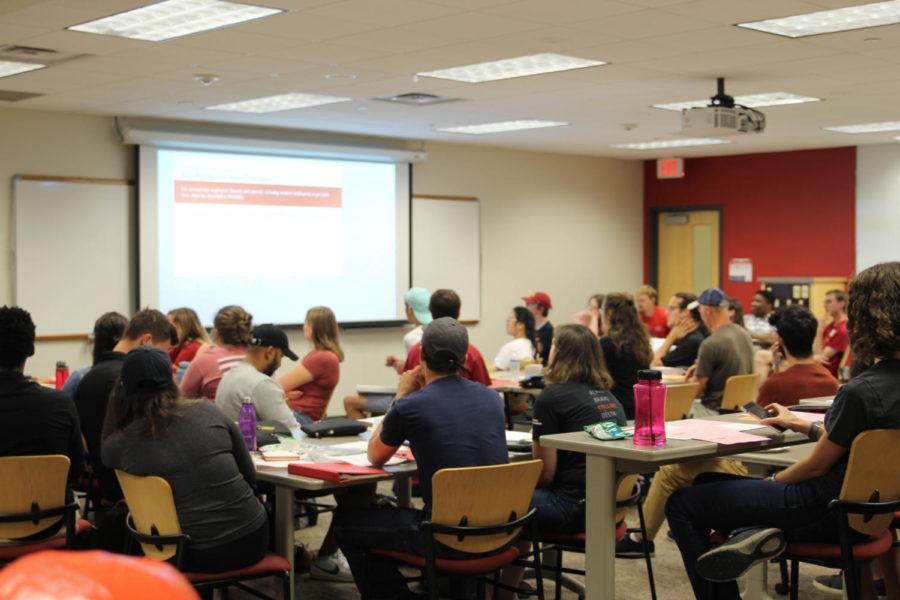Supplemental Instruction leader orientation to prepare leaders for semester
On Aug. 25 new and returning supplemental instruction leaders attend supplemental instruction leader orientation.
August 26, 2019
The Iowa State Supplemental Instruction leader orientation occurred the weekend before classes to prepare the new and returning Supplemental Instruction leaders for the school year.
The training was led by Leif Olsen, assistant director of Supplemental Instruction and psychology 131, Supplemental Instruction leaders from previous school years, Supplemental Instruction mentors and professional staff. The Supplemental Instruction leader orientation had many group discussions heavily focused on teaching the students how to be great leaders and what the goals of Supplemental Instruction are.
Olsen and his team began preparation for the leader orientation months in advance. They examined student feedback and decided how to best organize the orientation.
“Our goal of the orientation is to give the leaders an understanding of what their position is and how to have effective sessions that help the students learn,” Olsen said.
The team worked hard to improve the orientation process. In the past they had leaders say they were confused. This year the team concentrated on making sure the leaders understood the information and had fun with it. The leaders were in small groups and came together as a whole for conversation.
“The orientation is much better in comparison with the past,” said Ricardo Garza, graduate student in education and in the Dean of Students Office department. “We want them to feel confident in what it’s like to be a leader. They appreciate it even more, they want to be better and put the work in.”
The orientation put an emphasis on the fact that their statistics proves it works. Supplemental Instruction is a big part of Iowa State. The orientation teaches the Supplemental Instruction leaders what their purpose is and aims to make them confident in their performance.
According to the Academic Success Center, the Supplemental Instruction assessment of the 2018-2019 academic year revealed Supplemental Instruction participants earned an average of 0.28 higher GPA in fall 2018 and a 0.23 higher GPA in spring 2019. Throughout the year Supplemental Instruction leaders had collectively more than 55,000 contact hours with their students.
The interactions between the Supplemental Instruction leaders and their peers is important for the leaders to think about. The experienced leaders at the orientation shared what they had learned from the sessions, how to effectively communicate with professors and their students as well as their favorite aspects of being a Supplemental Instruction leader.
“I enjoy helping students the most,” said Matthew Hermsenwhite, senior in mechanical engineering and Supplemental Instruction leader for Chemistry 177. “I like the one-on-one interactions and like to see students come in nervous and frustrated but leave feeling relieved.”
Experienced Supplemental Instruction leaders also receive instruction from Supplemental Instruction mentors. There are two full time mentors and six leaders that also mentor. The mentors have biweekly meetings to see where everyone is at and what they want to focus on. These mentors aide the leaders in creating lesson plans and answer any questions they may have.
The Supplemental Instruction mentors get to experience the leader side of the job and the role of mentor position.
“The most rewarding aspect is seeing them [students attending Supplemental Instruction] understand something you help explain,” said Kia Birnbaum, senior in chemical engineering and Supplemental Instruction mentor. “I can see it click in their eyes, it’s the best feeling.”
A benefit of the Supplemental Instruction is that both leaders and mentors have the opportunity to receive internships based on references from Supplemental Instruction. Olsen has received calls from places like John Deere asking about students who have participated as a Supplemental Instruction leader.
The goals of being a Supplemental Instruction leader were discussed throughout the orientation. A focus was put on assuring that Supplemental Instruction sessions are diverse and inclusive.
“Everybody is coming from different backgrounds,” Garza said. “Such as some people have parents who went to college so they kind of know the ins and outs of ‘don’t forget to see a tutor, don’t forget to talk to your advisor’ but someone who’s coming in as a first generation student, they’re kind of at a disadvantage so you suit your sessions to be open to anybody with any type of background.”
Supplemental Instruction study sessions are meant to be a comfortable environment for students to learn the class material. Some students may also have a language barrier or a disability that needs to be accommodated.
Part of the leader orientation included case studies. The groups were given specific scenarios and talked about different ways to properly handle the situations and what resources are available to them.
There were also breaks that allowed the Supplemental Instruction leaders to have casual conversations with those in their group as well as the other groups nearby. This showed the community aspect of Supplemental Instruction by letting the leaders get to know each other and discuss what they were learning during the orientation.
The orientation also covered the business side of Supplemental Instruction. Olsen went through the mandatory meetings and deadlines expected of the leaders.
They discussed promoting their Supplemental Instruction sessions. The Supplemental Instruction leaders are expected to attend the class they are working with at the beginning of the year to introduce themselves and let students know about Supplemental Instruction.
The leaders will have the students fill out a scheduling survey to pick the most convenient time in hopes that the largest amount of students can attend.
Returning Supplemental Instruction leaders and the professional staff shared their advice and personal experience throughout the orientation.
“Supplemental Instruction is a great opportunity to reinforce what you’re learning in lectures,” Olsen said. “Students get to work in groups and engaging activities. It helps them become better students.”
Olsen closed out the leader orientation with the week one checklist that needed to be completed and talked through the payment process using the Workday system.







